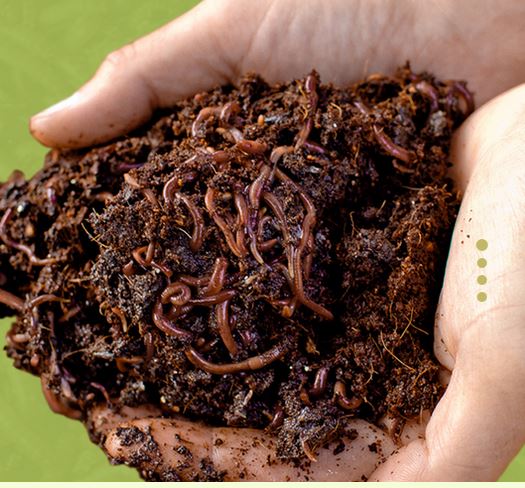Comprehending the Conveniences of Red Wiggler Composting: Exactly How This Efficient Approach Transforms Organic Waste Into Nutrient-Rich Dirt Amendments
Red Wiggler composting, employing the types Eisenia fetida, provides a compelling strategy to natural waste management, converting cooking area scraps and backyard debris right into beneficial soil changes. This method not only enhances soil fertility however likewise addresses pressing ecological problems, consisting of garbage dump waste reduction and greenhouse gas emissions.
What Are Red Wigglers?
Red wigglers, scientifically known as Eisenia fetida, are a species of earthworm that play an essential function in vermicomposting systems. These worms are identified by their reddish-brown color, segmented bodies, and an unique ability to flourish in organic-rich atmospheres, making them perfect for composting applications - Red Wiggler Composting. Unlike their garden-dwelling counterparts, red wigglers prefer to inhabit the upper layers of dirt, where rotting issue is plentiful
Usually measuring between 3 to 4 inches in size, red wigglers have a high reproductive price, enabling them to increase swiftly under optimum conditions. They possess a special digestive system that allows them to process natural waste efficiently, transforming it right into nutrient-rich castings, which are highly valuable for plant growth.
Their resistance to differing dampness levels and temperature ranges even more enhances their energy in vermicomposting arrangements, making them a favored choice amongst composting enthusiasts. Additionally, red wigglers are cardiovascular organisms, which demands a well-aerated composting environment, making certain reliable decay. Recognizing the organic qualities and behaviors of red wigglers is crucial for enhancing their usage in sustainable waste monitoring methods.

Benefits of Vermicomposting
Harnessing the power of vermicomposting deals a multitude of environmental and farming benefits. It dramatically decreases natural waste in land fills, thereby reducing methane discharges, a powerful greenhouse gas. By drawing away food scraps and backyard waste to vermicomposting, we sustain a more sustainable waste administration system.
Furthermore, vermicomposting boosts dirt wellness. The spreadings generated by red wigglers are rich in vital nutrients, microbes, and enzymes, improving dirt framework and fertility. This nutrient-rich amendment promotes robust plant development and raises water retention, reducing the need for chemical fertilizers.
Moreover, vermicomposting fosters biodiversity in the soil community. The introduction of helpful microbes from worm spreadings help in illness reductions and nutrient biking, developing a healthier setting for plants.
Financially, vermicomposting lowers the prices linked with chemical inputs and waste disposal. Farmers and gardeners can grow high-quality fruit and vegetables at reduced expenditures, adding to food safety and sustainability.
Just How to Begin Composting
Starting a composting venture can be a uncomplicated and satisfying procedure. To begin, pick an ideal location that is well-drained and obtains partial sunshine. This will aid preserve a balanced temperature level, critical for the composting procedure. Next, choose a garden compost bin or create a marked area in your garden, guaranteeing it is quickly accessible for collecting and adding materials garden compost.
Collect organic products such as kitchen area scraps, lawn waste, and shredded paper. Go for a well balanced mix of 'eco-friendly' products, high in nitrogen (e.g., fruit scraps, coffee grounds), and 'brownish' materials, abundant in carbon (e.g., dried fallen leaves, cardboard) A ratio of approximately 2:1 environment-friendly to brown products is perfect.
Beginning layering your materials, making certain sufficient air blood circulation by turning the stack frequently. This advertises aerobic decay, speeding and reducing odors up the procedure. Display moisture levels; the garden compost should feel like a wet sponge however not extremely wet.
Nutrient Profile of Vermicompost
Composting, especially with red wigglers, yields a nutrient-rich product referred to as vermicompost. This natural modification is distinguished by its high concentration of necessary nutrients, making it an important resource for horticulture and farming. Vermicompost typically includes elevated levels of macronutrients such as phosphorus, nitrogen, and potassium, which are important for plant growth. Additionally, it supplies trace elements like calcium, magnesium, and iron, fostering robust plant development and boosting soil health.
The microbial task present in vermicompost even more enriches its account, presenting valuable microorganisms and fungis that promote vitamins and mineral availability and uptake in plants. This biological element aids in reducing plant diseases and improving dirt framework, bring about improved water retention and aeration.

Ecological Impact of Composting
The environmental effect of composting, particularly with the usage of red wigglers, is multifaceted and profound. This approach substantially decreases the quantity of organic waste sent to landfills, which consequently lessens greenhouse gas discharges, specifically methane-- a potent factor to environment change. By diverting natural products from landfills, red wiggler composting not only assists mitigate ecological destruction but likewise promotes sustainable waste management methods.

Furthermore, composting adds to carbon sequestration, as the procedure try this out captures co2 from the atmosphere and shops it in the dirt. This all-natural procedure aids in combating climate change while enriching the soil - Red Wiggler Composting. Overall, red wiggler composting presents a viable, eco-friendly solution for waste management and ecological sustainability, advertising healthier communities and a much more lasting future
Final Thought
In conclusion, Red Wiggler composting serves as an effective approach for converting natural waste right into useful soil changes. The procedure not just enhances soil fertility and structure yet also alleviates environmental problems associated with waste disposal.
Red Wiggler composting, using the types Eisenia fetida, offers an engaging approach to organic waste management, transforming kitchen scraps and yard particles right into useful dirt modifications. Unlike their garden-dwelling counterparts, red wigglers choose to live in the upper layers of dirt, where rotting issue is bountiful.
The spreadings produced by red wigglers are abundant in essential nutrients, microorganisms, and enzymes, boosting dirt structure and fertility. The nutrient-rich results of red wiggler activity enhance dirt framework, increase water retention, and advertise biodiversity within the dirt ecosystem.In conclusion, Red Wiggler composting offers as an effective technique for transforming natural waste into valuable soil changes.